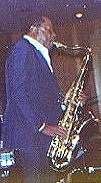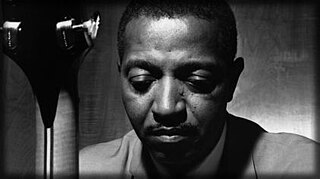Related Research Articles

William James "Count" Basie was an American jazz pianist, organist, bandleader, and composer. In 1935, he formed the Count Basie Orchestra, and in 1936 took them to Chicago for a long engagement and their first recording. He led the group for almost 50 years, creating innovations like the use of two "split" tenor saxophones, emphasizing the rhythm section, riffing with a big band, using arrangers to broaden their sound, and others. Many musicians came to prominence under his direction, including the tenor saxophonists Lester Young and Herschel Evans, the guitarist Freddie Green, trumpeters Buck Clayton and Harry "Sweets" Edison, plunger trombonist Al Grey, and singers Jimmy Rushing, Helen Humes, Thelma Carpenter, and Joe Williams.

Joe Williams was an American jazz singer. He sang with big bands such as the Count Basie Orchestra and the Lionel Hampton Orchestra and with his combos. He sang in two films with the Basie orchestra and sometimes worked as an actor.

Frank Wellington Wess was an American jazz saxophonist and flutist. In addition to his extensive solo work, Wess is remembered for his time in Count Basie's band from the early 1950s into the 1960s. Critic Scott Yanow described him as one of the premier proteges of Lester Young, and a leading jazz flutist of his era—using the latter instrument to bring new colors to Basie's music.

Edward F. Davis, known professionally as Eddie "Lockjaw" Davis, was an American jazz tenor saxophonist. It is unclear how he acquired the moniker "Lockjaw" : it is either said that it came from the title of a tune or from his way of biting hard on the saxophone mouthpiece. Other theories have been put forward.
Paul Quinichette was an American jazz tenor saxophonist. He was known as the "Vice President" or "Vice Prez" for his emulation of the breathy style of Lester Young, whose nickname was "The President", or simply "Prez". Young called Quinichette "Lady Q".

Eugene Edward "Snooky" Young was an American jazz trumpeter. He was known for his mastery of the plunger mute, with which he was able to create a wide range of sounds.

Thaddeus Joseph Jones was an American jazz trumpeter, composer, and bandleader who has been called "one of the all-time greatest jazz trumpet soloists".

Doug Lawrence is an American jazz tenor saxophonist from Lake Charles, Louisiana.

The Count Basie Orchestra is a 16- to 18-piece big band, one of the most prominent jazz performing groups of the swing era, founded by Count Basie in 1935 and recording regularly from 1936. Despite a brief disbandment at the beginning of the 1950s, the band survived long past the big band era itself and the death of Basie in 1984. It continues under the direction of trumpeter Scotty Barnhart.

Frederick William Green was an American swing jazz guitarist who played rhythm guitar with the Count Basie Orchestra for almost fifty years.
Joseph Dwight Newman was an American jazz trumpeter, composer, and educator, best known as a musician who worked with Count Basie during two periods.
Marshal Walton Royal Jr. was an American jazz alto saxophonist and clarinetist best known for his work with Count Basie, with whose band he played for nearly twenty years.

Frank Benjamin Foster III was an American tenor and soprano saxophonist, flautist, arranger, and composer. Foster collaborated frequently with Count Basie and worked as a bandleader from the early 1950s. In 1998, Howard University awarded Frank Foster with the Benny Golson Jazz Master Award.
Charles Baker Fowlkes was an American baritone saxophonist who was a member of the Count Basie Orchestra for over twenty-five years.

Herschel "Tex" Evans was an American tenor saxophonist who was a member of the Count Basie Orchestra. He also worked with Lionel Hampton and Buck Clayton. He is also known for starting his cousin Joe McQueen's interest in the saxophone. Joe McQueen, living until 2019 at age 100, may well have been the last surviving person to have known Herschel during his lifetime.
Preston Haynes Love was an American saxophonist, bandleader, and songwriter from Omaha, Nebraska, United States, best known as a sideman for jazz and rhythm and blues artists like Count Basie and Ray Charles.

Count Basie at Newport is a live album by jazz musician Count Basie and his orchestra. It was originally issued as Verve MGV 8243 and included only the tracks 1-7 and 13. Tracks 9-12 originally included in Count Basie & Joe Williams/Dizzy Gillespie & Mary Lou Williams at Newport.
Eric "Big Daddy" Dixon was an American jazz tenor saxophonist, flautist, composer, and arranger.
Benny Powell was an American jazz trombonist. He played both standard (tenor) trombone and bass trombone.
William Henry Hughes was an American jazz trombonist and bandleader. He spent most of his career with the Count Basie Orchestra and was the director of that ensemble until September 2010.
References
- ↑ "Johnny Williams (ii)". The New Grove Dictionary of Jazz . 2nd edition, ed. Barry Kernfeld.